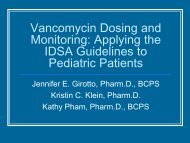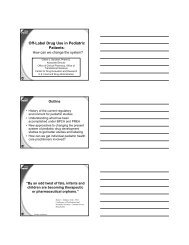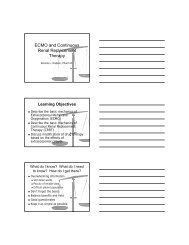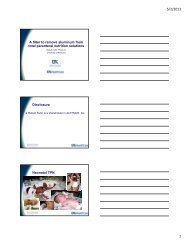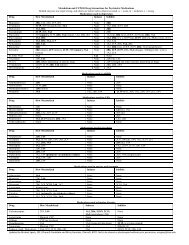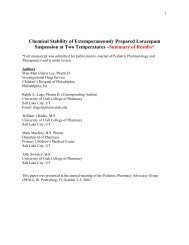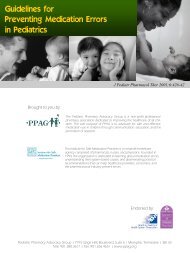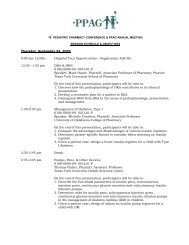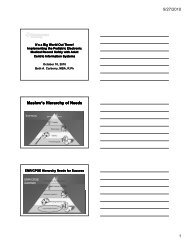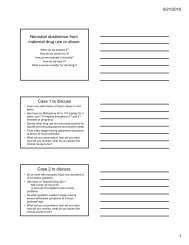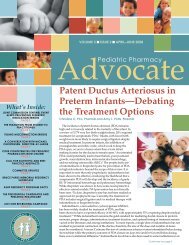Pharmacogenomics-Applications in Pediatric Oncology - PPAG
Pharmacogenomics-Applications in Pediatric Oncology - PPAG
Pharmacogenomics-Applications in Pediatric Oncology - PPAG
You also want an ePaper? Increase the reach of your titles
YUMPU automatically turns print PDFs into web optimized ePapers that Google loves.
3/8/2011Adoption of pharmacogenetic test results <strong>in</strong>tocl<strong>in</strong>ical practice has been slow•Anticipate that over a period of many years, there willbe a gradual <strong>in</strong>crease <strong>in</strong> evidence to support <strong>in</strong>creasedadoption of genetic tests <strong>in</strong>to cl<strong>in</strong>ical practice.•Processes P will be needed dto <strong>in</strong>corporatepharmacogenetic test results <strong>in</strong>to rout<strong>in</strong>e patient care.Steps to Incorporate Cl<strong>in</strong>icalPharmacogenetics at St. Jude Children’sResearch HospitalBackground on Cl<strong>in</strong>icalPharmacok<strong>in</strong>etics Service• All TDM results verifed by pharmacist• All TDM results accompanied by cl<strong>in</strong>ical pharmacy consult6
3/8/2011Cl<strong>in</strong>ical Decision Support anIntegral Component• Cl<strong>in</strong>ical decision support systems‐ <strong>in</strong>teractivecomputer programs designed to assist cl<strong>in</strong>icianswith decision mak<strong>in</strong>g tasks.Pharmacist enters abnormal genotypeElectronic flag l<strong>in</strong>ked to order for related drugMonitor<strong>in</strong>g TPMT Status Status <strong>in</strong> ALL Patients <strong>in</strong> ALL at Patients St JudeNewly dx’d ALL patientsDay 3 of <strong>in</strong>ductiontherapyWeek 7 of cont<strong>in</strong>uationtherapyWeek 17 of cont<strong>in</strong>uationtherapyTPMT genotype test<strong>in</strong>gby CLIA‐approved labRBC TGN/MeTIMPmeasuredRBC TPMT activitymeasuredResult entered <strong>in</strong>toelectronic med recordCl<strong>in</strong>ical Pharmacy Consultentered <strong>in</strong>to EMRCl<strong>in</strong>ical Pharmacy Consultentered <strong>in</strong>to EMRCl<strong>in</strong>ical Pharmacy Consultentered <strong>in</strong>to EMRIf patient meets any criteriaFor HET or Homozygous Variant StatusTPMT Status entered<strong>in</strong>to Problem List <strong>in</strong> EMRElectronic flag l<strong>in</strong>kedto thiopur<strong>in</strong>es <strong>in</strong> EMR6MP Doses adjusted to desired level of myelosuppressionTPMT Genotype Result and PharmacogeneticsConsult Entered <strong>in</strong>to EMR9
3/8/2011Therapeutic Drug Monitor<strong>in</strong>g andCl<strong>in</strong>ical Pharmacogenetics• TDM practices have <strong>in</strong>formed our approach, but keydist<strong>in</strong>ction exists• Pharmacogenetics provides a laboratory result that mayimprove dosage <strong>in</strong>dividualization‐‐‐without hav<strong>in</strong>g to givethe drug first• Advantages of pre‐emptive genotyp<strong>in</strong>g• Avoids turn‐around issues• Allows ample time to <strong>in</strong>terpret result• Genotype result ready to guide prescrib<strong>in</strong>gCYP2D6 and Code<strong>in</strong>e PharmacogeneticsCYP2D6 is major metabolic pathway forseveral classes of drugs•TCAs (nortriptyl<strong>in</strong>e, amitriptyl<strong>in</strong>e)•SSRIs (fluoxet<strong>in</strong>e, paroxet<strong>in</strong>e)•Atomoxet<strong>in</strong>e•Tamoxifen•Code<strong>in</strong>e•Beta blockers (metoprolol)•Anti‐arrhythmics (propafenone, fleca<strong>in</strong>ide)10
3/8/2011Frequency• Deficient• V/V• ~ 2‐10%• “PMs”CYP2D6 Drug Metabolism Phenotypesand Gene Polymorphisms• Heterozygous• Wt/V• ~ 30‐40%• “IMs”• Wt/Wt• ~ 60%• “EMs”• GeneDuplication(WT >2 )• ~ 0‐1%• “UMs”Low Enzyme activity/ drug clearance HighTranslat<strong>in</strong>g CYP2D6 CYP2D6 Genotype Genotype <strong>in</strong>to Phenotype <strong>in</strong>toPredictionPhenotype PredictionThe CYP2D6 Activity Score predicted by genotypes can predict the follow<strong>in</strong>g phenotypes:an AS of 0 = PM, an AS of 0.5 to 1.5 = IM, an AS of 2 = EM and an AS ≥ 2.5 = UM.Table adapted from: Gaedigk A, et al. Cl<strong>in</strong> Pharmacol Ther 2008;83:234.CYP2D6 and Code<strong>in</strong>e• CYP2D6 catalyzes code<strong>in</strong>eCode<strong>in</strong>e metabolism to morph<strong>in</strong>eCYP2D6• Typically a m<strong>in</strong>or pathway• Major pathway <strong>in</strong> UMs• Inherited enzymeCYP3A4 Morph<strong>in</strong>edeficiency does notalways mean moreglucuronidation toxicity!Norcode<strong>in</strong>e• Patients who <strong>in</strong>heritCYP2D6 deficiency canCode<strong>in</strong>e-6-glucuronide not activate code<strong>in</strong>e.11
3/8/2011Monitor<strong>in</strong>g CYP2D6 Genotype <strong>in</strong> <strong>in</strong> PatientsSt JudeNewly dx’d ALL patientsDay 15 of <strong>in</strong>ductiontherapyCYP2D6 genotype test<strong>in</strong>gby CLIA –approved labResult entered <strong>in</strong>toelectronic med recordCYP2D6 Activity Score assigned;Cl<strong>in</strong>ical Pharmacy Consultentered <strong>in</strong>to EMREM or IM StatusPM or UM StatusPM or UM Status entered<strong>in</strong>to problem listElectronic flagl<strong>in</strong>ked to prescrib<strong>in</strong>gof relevant meds <strong>in</strong> EMRCl<strong>in</strong>ical Decision Support:PG result enteredCl<strong>in</strong>ical Pharmacy Consult enteredPM or UM status entered <strong>in</strong>to Problem ListElectronic Alert activated when CYP2D6substrate prescribedPatient Case ZBCYP2D6 Poor Metabolizer• ZB is a 4 year‐old boy with newly diagnosed ALL,enrolled on frontl<strong>in</strong>e treatment on the St. Jude Total16 protocol. He has a whole blood sample obta<strong>in</strong>edon Day 15 for CYP2D6 genotyp<strong>in</strong>g, which gives aresult of *4/*4. The cl<strong>in</strong>ical pharmacist uses theCYP2D6 Activity Score table to determ<strong>in</strong>e that thepatient is a poor metabolizer.12
3/8/2011Translat<strong>in</strong>g CYP2D6 Genotype <strong>in</strong>to PhenotypeCYP2D6 PredictionActivity ScoreThe CYP2D6 AS predicted by genotypes can predict the follow<strong>in</strong>g phenotypes: an AS of 0= PM, an AS of 0.5 to 1.5 = IM, an AS of 2 = EM and an AS ≥ 2.5 = UM.Table adapted from: Gaedigk A, et al. Cl<strong>in</strong> Pharmacol Ther 2008;83:234.Patient Case ZBCYP2D6 Poor Metabolizer• The cl<strong>in</strong>ical pharmacist speaks with ZB and hisparents and learns that he has been prescribedcode<strong>in</strong>e PRN for pa<strong>in</strong> associated with v<strong>in</strong>crist<strong>in</strong>eneuropathy, which has had no effect. Thepharmacist documents the genotype result <strong>in</strong> theEMR, and recommends start<strong>in</strong>g gabapent<strong>in</strong>. Thepatient’s pa<strong>in</strong> subsequently resolves.Lab tests andphenotype consult aremodified fromtemplates and entered<strong>in</strong>to pt medical record13
3/8/2011Problematic genotypesare entered <strong>in</strong>toproblem listDecision support:L<strong>in</strong>ks problemgenotypes to drugorder<strong>in</strong>g, prescrib<strong>in</strong>g,and adm<strong>in</strong>istrationIf a cl<strong>in</strong>ician selects amedication that isl<strong>in</strong>ked to the specificpharmacogenetic alert(e.g. code<strong>in</strong>e &CYP2D6), a Warn<strong>in</strong>g Boxwill appear with a briefdescription of thepotential problem.The cl<strong>in</strong>ician is thendirected to select anappropriate actionbefore proceed<strong>in</strong>g.Summary of Cl<strong>in</strong>icalPharmacogenetics at St. Jude• Modeled after our established TDM service• Current focus on TPMT and CYP2D6 <strong>in</strong> ALL patients• Represents about 8% of TDM consults each month• Implementation• Pharmacists <strong>in</strong>terpret results, which requiredtra<strong>in</strong><strong>in</strong>g (e.g., activity score for CYP2D6)• Apply<strong>in</strong>g cl<strong>in</strong>ical decision support <strong>in</strong> our electronicmedical record is a key aspectCrews et al. Amer J Health‐Syst Pharm 2011; 68:14314
3/8/2011How will the availability of highthroughputgenotyp<strong>in</strong>g change the landscape?• Potential for robust genotyperesults for pennies per test• Only need one test per lifetime• Ability to have multiple resultsready “pre‐emptively”• How do we implement cl<strong>in</strong>icalpharmacogenomics?PGEN4Kids Study: CLINICALIMPLEMENTATION OFPHARMACOGENETICSGoal: migrate pharmacogenetic tests fromlaboratory <strong>in</strong>to rout<strong>in</strong>e patient care, to be availablepreemptivelyWhy design a cl<strong>in</strong>ical trial aboutimplement<strong>in</strong>g cl<strong>in</strong>icalpharmacogenetics?• Our overarch<strong>in</strong>g mission is to establish acomprehensive process to enable cl<strong>in</strong>icians to makegenotype‐guided therapeutic decisions.16
3/8/2011PGEN4Kids will enforce structure on process tomove tests from high‐throughput platform tomedical recordCl<strong>in</strong>icianacceptanceGenotyp<strong>in</strong>gPlatformevaluationPatient/familyconsentDeterm<strong>in</strong>e eligibility for migrat<strong>in</strong>g<strong>in</strong>dividual test resultsProcess for migrat<strong>in</strong>g pharmacogeneticsdata to medical recordPGEN4Kids Process for anIndividual Gene• Evaluate evidence for the gene e.g., CYP2C19• Interpret genotypes‐‐ *2, *3, *17• Translate to phenotypes– EM, IM, PM, UM• Prioritize drugs to add– clopidogrel, voriconazole• Move genotype results data to EMR for all patients whohave been tested• Prioritize data for “problem list” and Decision Support• Educate patients, parents, cl<strong>in</strong>icians (at least annually)• Revise, RepeatThe processPGEN4Kids17
3/8/2011All cl<strong>in</strong>ical genotype results will be posted <strong>in</strong> EMRChallenges to def<strong>in</strong><strong>in</strong>g thisprocess• Decid<strong>in</strong>g what constitutes sufficientevidence to migrate a test <strong>in</strong>to rout<strong>in</strong>ecl<strong>in</strong>ical care• Need a mechanism through which datacan be vetted and consensus reached fortranslat<strong>in</strong>g cl<strong>in</strong>ical pharmacogenomic teststo the cl<strong>in</strong>ic• Cl<strong>in</strong>ical Decision Support is <strong>in</strong>tegralCPIC: Cl<strong>in</strong>ical PharmacogeneticsImplementation Consortium• Cl<strong>in</strong>icians, scientists, FDA, 3 rd partypayors, patient representatives, socialworkers, etc• Provid<strong>in</strong>g updated recommendations ongenotyp<strong>in</strong>g and drug dos<strong>in</strong>g18
3/8/2011Rell<strong>in</strong>g et al. Cl<strong>in</strong> Pharmacol Ther 201119
3/8/2011Patient Involvement• PGEN4Kids <strong>in</strong>cludes patient/familyeducation• Patients/families can choose their level of<strong>in</strong>volvement <strong>in</strong> the process ofimplement<strong>in</strong>g pharmacogenomicsSt. Jude Family Advisory Council• Great diversity of op<strong>in</strong>ion– From “why are you tell<strong>in</strong>g me this” to “I want to decide when thisgoes <strong>in</strong> record”• High level of <strong>in</strong>terest• Helped to put together educational DVD• Will rema<strong>in</strong> engaged <strong>in</strong> protocolConclusions• Prospective pharmacogenetic test<strong>in</strong>g <strong>in</strong> patients witha high likelihood of receiv<strong>in</strong>g drugs of <strong>in</strong>terest results <strong>in</strong> theidentification of patients at high risk for toxicity or lack of benefit.• Cl<strong>in</strong>ical decision support can enhance patient safety by provid<strong>in</strong>gautomated warn<strong>in</strong>gs dur<strong>in</strong>g the medication prescrib<strong>in</strong>g anddispens<strong>in</strong>g processes.• Implement<strong>in</strong>g cl<strong>in</strong>ical pharmacogenetics will help to realize thepromise of personalized medic<strong>in</strong>e.20
3/8/2011Potential of Personalized Medic<strong>in</strong>e: Gett<strong>in</strong>g the rightdose of the right drug to the right patientReferences1: Stearns V, Johnson MD, Rae JM, et al. Active tamoxifen metaboliteplasma concentrations after coadm<strong>in</strong>istration of tamoxifen and theselective seroton<strong>in</strong> reuptake <strong>in</strong>hibitor paroxet<strong>in</strong>e. J Natl Cancer Inst.2003 Dec 3;95(23):1758‐64.2: Yang JJ, Cheng C, Yang W, et al. Genome‐wide <strong>in</strong>terrogation ofgerml<strong>in</strong>e genetic variation associated with treatment response <strong>in</strong>childhood acute lymphoblastic leukemia. JAMA. 2009 Jan 28;301(4):393‐403.3: Ensom MH, Chang TK, Patel P. Pharmacogenetics: the therapeuticdrug monitor<strong>in</strong>g of the future? Cl<strong>in</strong> Pharmacok<strong>in</strong>et. 2001;40(11):783‐802.4: Gaedigk A, Simon SD, Pearce RE, et al. The CYP2D6activity score: translat<strong>in</strong>g genotype <strong>in</strong>formation <strong>in</strong>to a qualitativemeasure of phenotype. Cl<strong>in</strong> Pharmacol Ther. 2008 Feb;83(2):234‐42.References5: Crews KR, Cross SJ, McCormick JN, et al. Development andimplementation of a pharmacist‐managed cl<strong>in</strong>icalpharmacogenetics service. Am J Health Syst Pharm. 2011 Jan15;68(2):143‐50.6: Rell<strong>in</strong>g MV, Gardner EE, Sandborn WJ, et al. Cl<strong>in</strong>icalpharmacogenetics implementation consortium guidel<strong>in</strong>es forthiopur<strong>in</strong>e i methyltransferase hl genotype and thiopur<strong>in</strong>eidos<strong>in</strong>g. Cl<strong>in</strong> Pharmacol Ther. 2011 Mar;89(3):387‐91. Epub 2011Jan 26.7: McLeod HL, Krynetski EY, Rell<strong>in</strong>g MV, Evans WE. Geneticpolymorphism of thiopur<strong>in</strong>e methyltransferase and its cl<strong>in</strong>icalrelevance for childhood acute lymphoblastic leukemia.Leukemia. 2000 Apr;14(4):567‐72.21



